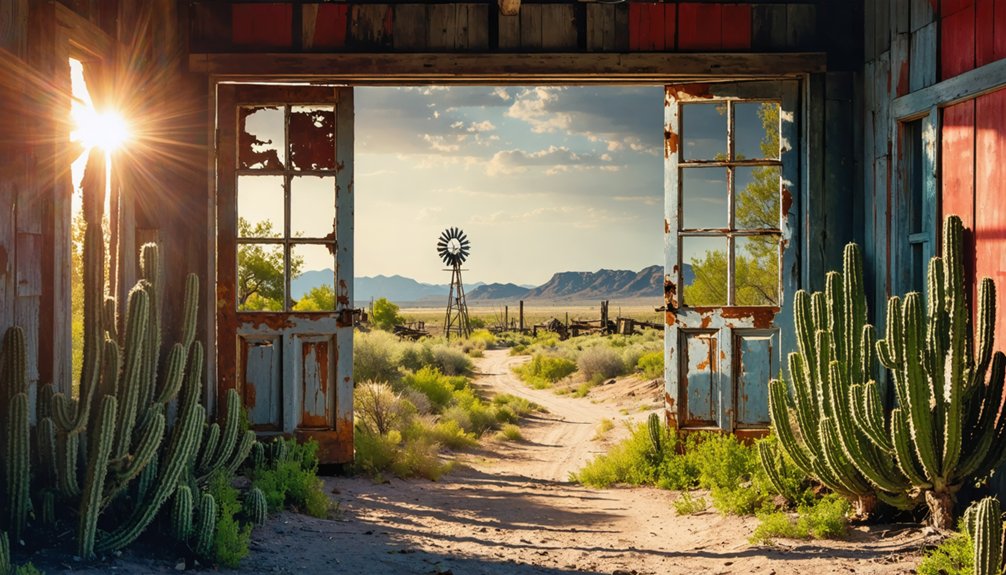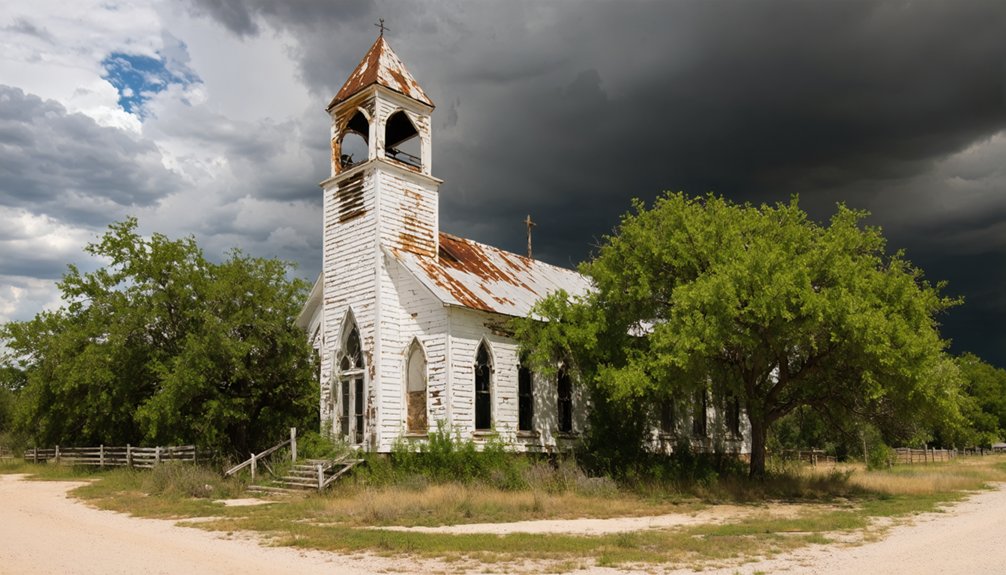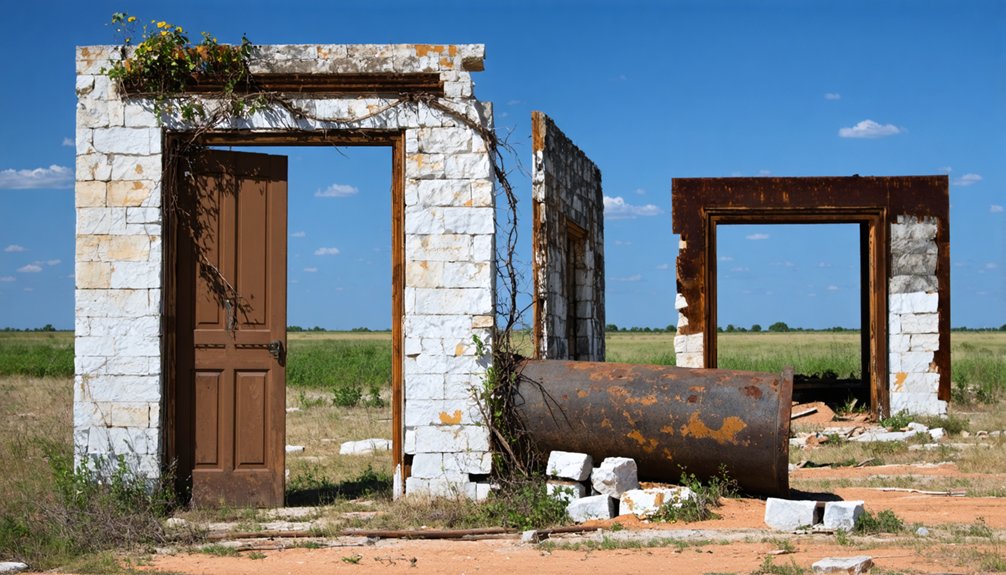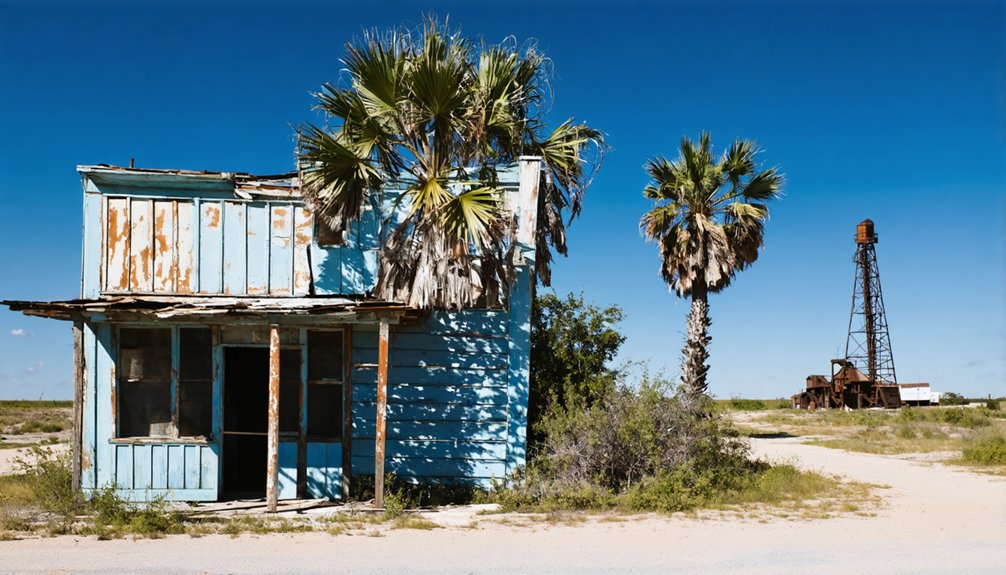You’ll find Palm Valley’s ghost town remnants near Round Rock, Texas, where Swedish immigrant Anna Palm established a homestead in the 1850s. After her husband’s death, she led seven children and encouraged Swedish settlement in this fertile region. The community flourished around Palm Valley Lutheran Church, established in 1868, but gradually declined despite economic growth. Today, you’ll discover abandoned structures, a historic cemetery, and architectural ruins that tell a fascinating story of Swedish pioneer perseverance.
Key Takeaways
- Palm Valley transformed from a thriving Swedish farming community to a ghost town following economic changes and rural population decline.
- Founded by Anna Palm in the 1850s, the settlement began with her homestead and grew through Swedish immigration.
- The Palm Valley Lutheran Church, established in 1868, remains the primary surviving structure from the original community.
- Architectural remnants include limestone foundations, collapsed buildings, and debris marking former post office and general store locations.
- The area experienced significant population decrease, dropping from 1,413 residents in 2020 to 1,325 by 2025.
The Swedish Pioneer Legacy of Anna Palm

While many Texas ghost towns have faded into obscurity, Palm Valley‘s origins trace back to the remarkable story of Anna Palm, a Swedish immigrant who shaped the region’s destiny in the 1850s.
After her husband’s death in 1853, you’ll find inspiration in how she led her seven children through pioneer life, living in a tent and wagon before building a log cabin near present-day Round Rock.
Anna Palm’s resilience shone through as she guided her seven children from tent life to building their Texas homestead.
She didn’t just survive – she thrived, clearing brush, hunting game, and fishing in Brushy Creek. The Comanche raids posed constant threats to her family’s safety and survival.
Her influence on Swedish immigration to Texas grew as she actively encouraged others to settle in the fertile region.
The community that flourished around her homestead expanded into what you’d recognize today as Palm Valley, encompassing Round Rock, Georgetown, Hutto, and New Sweden. Her brother Swante Palm would later become a prominent figure, with his extensive library donation to UT shaping Texas cultural heritage.
Settlement Origins and Early Challenges
If you’d visited Palm Valley in the 1830s, you’d have found Kenney’s Fort as your primary refuge, with its four log cabins featuring strategic portholes and sturdy gates designed to protect early settlers.
The fort’s location near Chandler Branch and Brushy Creek served as the community’s nucleus, where pioneer families lived in close quarters while establishing their foothold in the Texas frontier.
Though Swedish pioneer Anna Palm would later give the settlement its name, the earliest defensive fortifications and community cooperation at Kenney’s Fort laid the groundwork for Palm Valley’s development.
Like many frontier settlements that faced sudden abandonment, the town experienced periods of uncertainty when natural disasters threatened its survival.
Like the residents of the ghost town of Ayr, the settlement faced the harsh reality that losing key elections could determine a community’s fate.
Swedish Pioneer Roots
As Swedish immigrants first arrived in Texas during 1848, Swante M. Swenson led the way, bringing 25 settlers who’d help establish new lives in the Lone Star State.
You’ll find their immigrant stories deeply rooted in Palm Valley, where families from Småland’s Barkeryd parish sought freedom and opportunity in Texas’s promising landscape. Sam Houston urged Swenson to recruit more Swedish settlers to help populate the region.
Despite financial hardships and cultural adjustments, these pioneers built strong foundations through mutual support and determination. Working as ranch hands and farmers to repay passage debts, they maintained their Swedish customs while adapting to Texas life.
The Palm family, particularly Swante Palm, played a vital role in helping new arrivals settle along Brushy Creek. Through kinship networks and community bonds, these settlers transformed the challenges of frontier life into lasting settlement success.
Fort Protection Systems
Before Swedish pioneers settled in Palm Valley, the area’s first defensive structure emerged in 1838 when Dr. Thomas Kenney, a Republic of Texas veteran, established a fort near Brushy Creek.
The fort design included four log cabins crafted from local elm and hackberry trees, surrounded by an eight-foot-high picket stockade fence that protected about 15 settlers.
You’ll find the defensive strategies were well-planned, with strategically placed port holes in cabin walls and east-west gates for controlled access.
The fort’s position on a bluff overlooking Brushy Creek provided significant vantage points for monitoring potential threats.
Located alongside the Double File Trail, an Indigenous route, the fort served as both a military outpost and a community hub, where settlers could farm, trade, and maintain cautious relations with local Indigenous peoples. Like other frontier settlements, the fort relied on horse-based mobility for defense and transportation, a practice that became essential after 1680. During this period of disputed territorial claims, the fort represented one of many strategic settlements established to assert control over the Texas region.
Kenney’s Fort: A Frontier Stronghold
During the tumultuous period of early Texas settlement, Dr. Thomas Kenney and Joseph Barnhart constructed an essential frontier stronghold in 1838 along Brushy Creek.
The fort’s architecture showcased innovative frontier defense features, including four strategically positioned log cabins with port holes and an imposing eight-foot stockade. You’ll find this fort served as Williamson County’s first permanent settlement, protecting up to 15 residents from wild animals and Native American raids. Many distinguished San Jacinto Battle veterans established homesteads in the vicinity of the fort. The fort’s strategic importance made it a natural rendezvous point for the 1841 Santa Fe Expedition.
At this critical location near the Double File Trail Crossing, the fort became central to Texas history, launching the Texan Santa Fe Expedition and playing a pivotal role in the Texas Archives War of 1842.
Built from elm and hackberry wood, Kenney’s Fort stood as a symbol of pioneer resilience until its eventual abandonment in the 1850s.
From Farmland to Ghost Town
While many Texas settlements faded into history, Palm Valley‘s evolution from a thriving Swedish farming community to a ghost town began in the mid-19th century.
When Anna Palm and her six sons established their homestead in 1853, they sparked a wave of Swedish immigration that would shape the area’s agricultural identity along State Highway 79. The original Palm Valley Lutheran Church became the heart of the community when established in 1870.
- Economic changes forced families to abandon traditional farming practices
- Rural depopulation accelerated as younger generations sought urban opportunities
- Technological advancements in agriculture reduced the need for manual labor
- Government policies favoring urbanization contributed to the community’s decline
You’ll find remnants of Palm Valley’s prosperous past in its Lutheran church, cemetery, and abandoned railroad stop, where weathered buildings stand as silent witnesses to the community’s journey from farmland prosperity to ghostly quietude.
Cultural Heritage and Religious Landmarks

As evidence to Palm Valley’s rich Swedish heritage, the Lutheran church and cemetery stand as enduring cultural landmarks that have anchored the community since 1868.
You’ll find the cemetery’s first burial site beneath what was once described as “the tallest oak tree,” on land donated by Anna Palm’s nephew. This sacred ground became a final resting place for her son and fellow Swedish immigrants.
Today, Palm Valley Lutheran Church continues its cultural preservation through active worship services and traditional events that honor the area’s Scandinavian roots.
Palm Valley Lutheran Church keeps Swedish heritage alive, blending timeless traditions with modern worship to celebrate its deep Scandinavian ancestry.
The church’s architecture reflects its religious significance, combining Scandinavian Lutheran design with local building materials.
Through ongoing maintenance and community support, these landmarks serve as living monuments to the determination of Swedish pioneers who shaped this Texas settlement.
Demographic Shifts and Community Changes
Since 2020, Palm Valley has experienced notable demographic shifts, with its population steadily declining from 1,413 residents to a projected 1,325 by 2025.
You’ll find population trends showing a dramatic 12% decrease between 2022-2023 alone, while the median age hovers around 47.3 years, reflecting significant aging effects on the community.
- White residents make up the largest demographic at 46-59%, followed by a strong Hispanic presence at 43-44%.
- Economic indicators show improvement with median household income rising from $69,773 to $92,000.
- Homeownership remains high at 76.5%, suggesting stable property values around $264,400.
- The community’s citizenship rate stands at 93%, with English as the predominant language despite diverse ethnic backgrounds.
Architectural Remnants and Lost Structures

Despite Palm Valley’s former prominence, you’ll find only scattered architectural remnants throughout the abandoned townsite today. The few surviving structures, mostly residential, showcase extensive architectural decay with collapsed roofs and weathered frames.
You’ll notice foundations and walls built from local limestone, typical of late 19th to early 20th century Texas frontier construction.
The town’s historical significance is evident in traces of lost public buildings. The schoolhouse and church, once essential community centers, have been reduced to mere foundations.
Where a post office and general store once stood, you’ll now see only debris. Time and nature have taken their toll – mesquite and grass overtake the ruins, while termites and wood rot continue to degrade the remaining wooden structures.
Historical Impact on Modern Round Rock
While Palm Valley itself now stands abandoned, its lasting influence on modern Round Rock remains evident through multiple channels of cultural and economic development.
You’ll find Palm Valley’s legacy deeply woven into Round Rock’s cultural integration and economic evolution.
- The Palm Valley Lutheran Church continues as a crucial cultural landmark, serving both descendants and new community members.
- Transportation infrastructure established by the settlement, including Palm Valley Boulevard, shaped Round Rock’s eastern expansion.
- Swedish immigrant support networks created lasting economic pathways that diversified Round Rock’s workforce.
- Agricultural innovations introduced by Palm Valley farmers transformed local farming practices and market systems.
The settlement’s impact echoes through modern street names, religious institutions, and transportation networks that you’ll encounter throughout Round Rock’s eastern corridor, proof of Palm Valley’s role in shaping the city’s development.
Frequently Asked Questions
What Natural Disasters or Events Contributed to Palm Valley’s Decline?
You’ll find drought conditions persistently challenged farming and ranching, while severe storms brought flood damage to the region, steadily wearing down the community’s resilience through recurring natural hardships.
Were There Any Notable Conflicts Between Swedish Settlers and Native Americans?
While major settler interactions marked Texas history, you won’t find records of notable conflicts between Swedish settlers and Native Americans in this area. Cultural exchanges were minimal as Swedes arrived after regional hostilities ended.
What Crops Were Primarily Grown by the Early Palm Valley Farmers?
You’ll find cotton cultivation dominated Palm Valley’s early farming scene, with corn and sorghum playing essential supporting roles in crop rotation. Farmers also raised livestock and experimented with various vegetables.
Did Palm Valley Have Its Own School System Before Becoming Abandoned?
You won’t find records of a standalone Palm Valley school system. The area’s education facilities were part of Williamson County’s broader school districts, with students likely attending Round Rock’s centralized schools.
What Traditional Swedish Customs Were Practiced in Early Palm Valley?
You’d find Swedish settlers celebrating Midsummer with dancing and feasting, practicing Fika traditions of coffee gatherings, and attending regular Lutheran church services in their native language at Palm Valley’s Swedish Lutheran Church.
References
- https://www.roundrocktexas.gov/the-quarry/2022/04/places-in-time-palm-valley/
- https://www.wilcotx.gov/DocumentCenter/View/15333/Palm-Valley
- https://www.palmvalleytx.gov/about-us/page/history-palm-valley
- https://en.wikipedia.org/wiki/List_of_ghost_towns_in_Texas
- https://www.wilcotx.gov/1635/Historical-Abandoned-Towns
- https://www.youtube.com/watch?v=-FQXNcUcAY0
- https://www.tshaonline.org/handbook/entries/palm-tx
- https://www.tshaonline.org/handbook/entries/palm-valley-tx-cameron-county
- https://www.roundrocktexas.gov/news/round-rock-city-council-recognizes-2021-local-legends/
- https://briscoecenter.org/research/online-reference-tools/subject-guides/swedes-in-texas/



